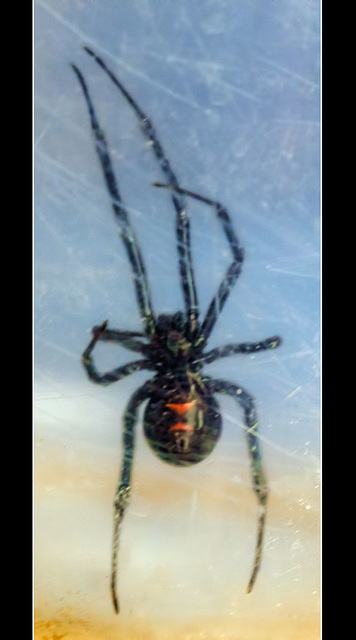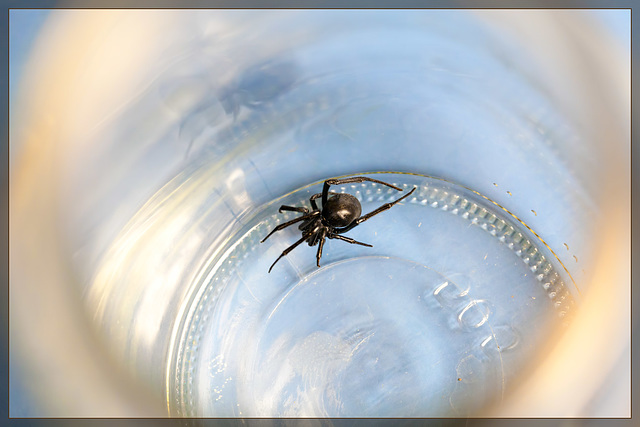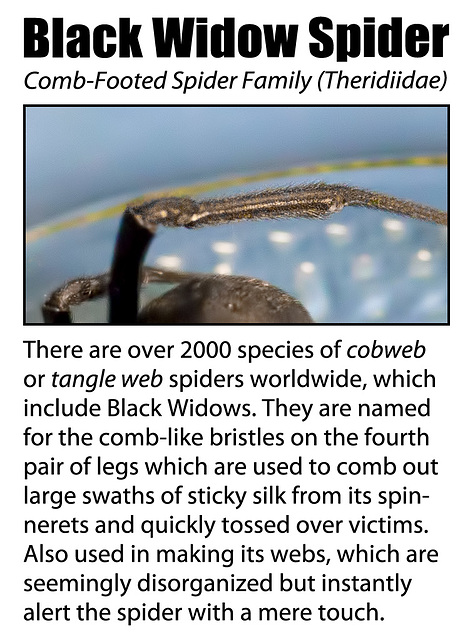
Black Widow Spider
I caught a Black Widow in our shop one evening and decided to keep her for a while to observe her and take pictures. I will be releasing her when I'm satisfied with my pictures and until then, she's getting the royal treatment, and fed insects every day!
02 Aug 2012
Venomous Beauty: The Black Widow Spider (STORY TIME!!)
When Steve and I moved up to the countryside of southern Oregon years ago, I was excited that we would be living in the midst of so much wildlife. However, in the first month of living here, I got a horrifying surprise when I saw a very large, inky-black spider under the stairs in our garage and discovered that it was, indeed, a Black Widow spider!! That one was the largest I have seen, with an abdomen of nearly half an inch in diameter!
Since then, I've been extremely careful about putting my hands in dark places. I've found several Black Widows, including a couple of tiny males, one of which was in our downstairs bathroom!!!
Since I got my new camera last November, I've been keeping my eyes open for Black Widows but they were nowhere to be seen, which was a little bit annoying because I know they are very common here. However, like many spiders, they are nocturnal, very shy, and run away at the first sign of something big and scary like a human.
About a week ago I went over to our shop and when I turned on the light, I found a large black spider moving across the floor and trying to get out of the light. I quickly found a container, carefully coaxed it in, popped a lid on and brought it to the house for a better look. As I watched, it climbed around the sides of the container and I saw what I was looking for! The classic hourglass markings on the bottom of the abdomen, showing this spider to be a female Black Widow! YES!!
I put her into a clear glass jar with the idea of taking pictures and then...what? Steve wanted to kill her immediately but I told him no--I want pictures! The internet sided with Steve; even those who like spiders draw the line at spiders which pose a threat to humans. Fair enough. But still she sat, lurking in her jar, awaiting her demise, as one day turned into three. I realized that she must be hungry, and even though she was sitting on death row, perhaps it would be fair to give her something to eat. So, I found a cucumber beetle that had wandered into the house and carefully popped it into the jar. A few hours later, the spider was feasting happily. Steve decided that our new guest was interesting too, and presented her with a beetle, which was captured and eaten with relish. Then for a real bit of fun...a wasp was buzzing around in the kitchen. A good whack with a fly swatter to disorient it, Steve grabbed it with a paper towel and stuffed it into the jar. Was that delight on his face when we found her chowing down an hour later? I know that was the expression on MY face!
Time to get serious. It was time to get back to the plan...pictures and a swift death. However, I discovered that taking pictures through curved glass doesn't work very well at all. Distortion from the curve of the glass ruins the picture and using a flash amplifies problems. What to do, what to do...ah yes! Let's put her into a square glass container! I found a plant seedling tray with a clear plastic dome, cleaned it up and lined it with white paper towels as a better contrast. I then eekingly (yes, that's a new word!) transferred her into it, popping the dome on top as she began scurrying to the edge of the tray! Make no mistake: I know EXACTLY what I'm dealing with here, and use great caution when there's nothing between me and this spider!
With the lid on, I sat and watched her as she crawled over to a corner. This should work well for pictures, I thought, and noticed that the plastic dome had two vents which slide open like little hatches...perfect for popping insects through! Let's try it out!
Bouncing up, I grabbed the fly swatter, went out to the trays of water we have for the birds, and smacked a wasp balanced on the surface tension. Before the drenched wasp could crawl out and fly away, I flicked it into a cup, covered it with the fly swatter, went inside and got the wasp through the opening into the dome, where it buzzed around in a fury, trying to find something to sting. I watched with a mad gleam in my eye...why, this was the best gladiator event ever! It didn't take long...the wasp would fly down to the floor and trip a few strands of the spider's web, and she should come running over. The wasp would climb up to the dome, out of harm's way, and she would return to her corner. But then it happened! The wasp flew down to the ground and wandered over to her corner, laden with sticky strands. It got stuck and tried to free itself, but before it could, the spider ran over and began throwing invisible strands over it here and there. The wasp tried to sting her, straining against the sticky web, trying to reach her with its stinger. It was no use. The harder it struggled, the worse it became stuck. All the while, she dashed in and out, busily tossing more strands, securing them here and there, and then, she moved off to the side and just waited. This was a surprise to me because I thought she'd just run in and bite it for an instant death, but she didn't. The wasp slowly exhausted itself, always straining that stinger and hoping desperately to find a target. Finally, when it was so immobilized and tired, she moved in and killed it instantly. An amazing battle, but an easy victory for this deadly foe.
As you can see, I've taken a picture, but it's not a good one. We've also discovered what fun it is to feed her wasps. So, we'll be keeping this spider for a while longer but I've decided that I would like to release her far from home, because the fact is that there are hundreds of these spiders all around our home, though we cannot see them. Her death would not make a difference in the number of these spiders, and frankly, I don't feel right about killing her. After all, this is her home. It is our job to be careful of the wildlife here, but it wasn't her fault that she found her way into our shop. (I'll be posting another picture or two in the future, along with more information about these spiders.)
27 Jul 2012
2 comments
Fascinating Facts About Widow Spiders!
This is the first picture I took of the Black Widow spider that I found in our shop. After crawling around the bottom of the translucent, plastic cup I'd coaxed her into, she finally climbed up the side, and this allowed me to instantly identify her. What you may not know is that some Black Widows do not display the characteristic hourglass or double triangular markings. I learned a lot about these spiders and I bet you'll be just as surprised as I was at some of this information!
There are 32 species of Widow spiders and they can be found all over the world with a few exceptions, northern Europe to name one. (However, they have False Widows, imported from the Canary Islands , to contend with instead!) There are three species known as "Black Widow Spiders," all which live in the United States, Canada and Mexico.
Some interesting facts about Widow Spiders:
• Not all Widow spiders are black! There are many species which are brown, and they also come in white, red, and beautiful spotted patterns of black or brown with white and red markings. (The Elegant Widow Spider from Japan is stunning!)
• These spiders get the name "Widow" due to a behavior seen where the female kills and eats the male after mating. However, males are usually not killed and leave unharmed after mating. The fact is that almost all female spiders of every species will occasionally kill the male after mating.
• Widow spiders have voluntary control of the venom they inject, and this is one of the reasons it's so difficult to distinguish the potency of poison from one species to the next.
• Widow spiders are nocturnal, very shy, and will run away if disturbed.
• Widow spiders are not aggressive and will not bite humans unless they are being hurt and cannot get away.
• Like most spiders, male Widow spiders are much smaller than females (about 1/3 size compared to a female) and they are harmless to humans.
• The bite from a Black Widow spider can be fatal but this is extremely rare . Children are most at risk, as are the elderly and those with heart conditions. That being said, the neurotoxin Latrotoxin from a Black Widow bite is extremely painful and can last weeks to completely dissipate.
• Black Widow spiders are not the most dangerous spider in the world! That ominous title goes to the very deadly Brazilian Wandering Spider. (I'll be doing a post about dangerous spiders tomorrow!)
• Many Widow species are not particularly dangerous, especially Brown Widows.
If you would like more information about these spiders, the source of the range map linked above has an excellent page too: Information about Black Widow Spiders. (Wiki also has a page about these spiders with excellent information about individual species' locations, but the information about venom and cannibalism is wrong; I therefore don't trust the validity of this page after researching a number of sites and sources about these spiders.)
27 Jul 2012
The Most Dangerous Spiders in the World!
Here is my Black Widow spider huddling at the bottom of the jar I first placed her in after capturing her in a plastic cup. I soon found that taking pictures through a glass jar doesn't work very well because of distortion and glare. However, this image through the top gives one the feeling of peering in to take a better look. What you don't know is that the second I put the lid back on, she raced up an unseen thread to the opening and I was rather alarmed to realize how quickly she could have escaped, just moments after I'd got her into the house! To put it mildly, "EEEEEEK!!!" :D
Keeping this Black Widow temporarily for observation is a wonderful opportunity for learning more about these spiders, and the first thing I wondered was, "What spider is the most dangerous in the world?" Unfortunately, though the internet is full of information, much of it is wrong, so it takes a bit of time to cross reference for the truth. However, I set about putting a list together and I wasn't surprised to find that the famous Black Widow is NOT the world's most dangerous spider!
By the way, do you know the difference between poisonous and venomous ? Poison is absorbed or ingested and only affects a creature that touches or eats it. Venom is always injected by a variety of methods: bite, sting, tail stab, spine slash, spur spike, etc. A spider injects poison through its venom glands, which makes it a venomous creature. Animals like Poison Dart frogs secrete toxins through their skin, which makes them a poisonous creature.
I originally planned to do a little write up on each of the spiders in the following list but in the end decided that it would be better to just link to pages about each spider if viewers want to know more! :D ENJOY! :)
The World's Most Dangerous Spiders:
1. Brazilian Wandering Spider
2. Australian Funnel Web Spider
3. Six-Eyed Sand Spider
4. Australian Mouse Spider
5. Recluse Spiders
6. Widow Spiders (especially Black Widows, Redback and a few other species)
7. Hobo Spiders
8. Yellow Sac Spider
9. Tarantulas (many species are basically harmless to humans)
10. Wolf Spiders
02 Aug 2012
The EZ Snack 2000!
"The EZ Snack 2000! No fuss! No muss! The fast and easy way to get insects served to your web with no effort on your part! This fabulous spider-friendly habitat is spacious, clean and comes delivered and ready to move into for the low, low price of just $29.99! ORDER TODAY!!! 1-800-EZ-SNACK"
**Some assembly required, willing human slave not included, offer void where prohibited by arachnophobes.
Here's a picture of my Black Widow spider with two paper wasps, wrapped and ready for snacking! What a life she has these days! All she has to do is relax in style, and out of nowhere, more insects appear in her habitat!What a deal!! It has been fun to watch her chowing down on the wasps that are swarming around this summer. Steve put seven wasps in a couple of days ago and there are only two left this evening, what a little piggy!! (Her habitat is a seedling tray with a plastic dome on top, lined with white paper towels. The dome has two sliding hatches on top that open and close securely, and the dome is taped closed to ensure she doesn't get out! :D)
I have read that these spiders bite their prey and then wait for them to stop moving before moving in to eat, but this particular spider does not do that. When she's ready to eat, she'll run over to a wasp that's alerted her and quickly begin tossing swaths of sticky silk on it. She ties off strands here and there, and the insect is quickly immobilized and soon can barely move. After waiting a few more minutes for it to become exhausted, she then goes in and bites it behind the head, causing it to die almost instantly. A Black Widow injects a powerful neurotoxin that affects the nervous system, quickly paralyzing and then killing the insect.
(Warning: gross details ahead!) Once their prey is dead, they go to the bite site and begin chewing the area, releasing digestive enzymes that liquefy the animal's insides, which are then sucked out. After my spider is done with her feast, she carefully detaches the insect from her web and lets it fall to the ground. She will sometimes pull the insect husks into a pile, where they sit like gruesome trophies!
This will be the last Black Widow spider picture for a while. I plan to take a couple more before I release her far, far, far, far, far from my house, but I think we've all had enough creepy pictures for now! I hope you've enjoyed these! It's been so much fun learning about these spiders and sharing the information with all of you! Thanks for your great comments and encouragement, you guys make me feel GREAT! *hugs* :D
04 Aug 2012
Why the Black Widow Spider is in the Comb-footed Family
This is a close-up of a back leg of a Black widow spider. As you can see, it's covered with little bristles. These are used for combing large swaths of silk from their spinnerets and tossing it quickly over a victim to ensnare it. They also use these combs in the building of their webs.
There are over 2000 species in the Comb-Footed spider family (Theridiidae), found world-wide. Most are fairly harmless, with exception of the Widow spiders, some of which are among the most venomous in the world.
These spiders are also known as cobweb or tangleweb spiders because they create dense webs of disorganized, sticky threads to capture their victims. These webs are enlarged over time and a single touch will alert the lurking spider.
Did you know that spiders have up to four types of silk? They can place these strands at will depending on what is needed at the moment! Each type of silk comes out of its own spinnerets, and the link here will show you a magnified image of a spider's spnnerets with silk strands being pulled out!
If you would like to know more about Comb-Footed spiders, Wiki has a nice page here: Wiki: Theridiidae . For more information about spider silk, this is a wonderful source! Spider Silk
Jump to top
RSS feed- Latest items - Subscribe to the latest items added to this album
- ipernity © 2007-2024
- Help & Contact
|
Club news
|
About ipernity
|
History |
ipernity Club & Prices |
Guide of good conduct
Donate | Group guidelines | Privacy policy | Terms of use | Statutes | In memoria -
Facebook
Twitter






